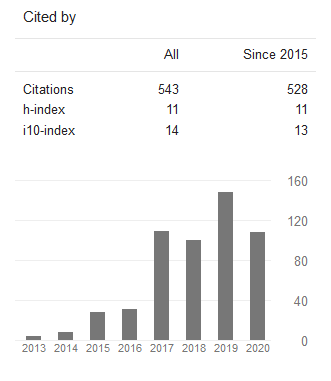New Edge Detection Method Using Elisabeth Method: Case Study Javanese Batiks
DOI:
https://doi.org/10.24002/jbi.v1i1.289Abstract
Abstract. This article will introduce a new edge detection method called Elisabeth method to analyze image. The case study here is Javanese Batik’s motif. Edges are basic low level primitives for image processing. It helps to identify pictures. Methods used are the combination between Sobel and Prewitt. This method is completely new to analyze Javanese Batik’s motif. Every batik motif has unique pattern. The purpose of this research is to improving edge detection method that already known now. The result is a new method in edge detection problems. Batik is one of the Indonesian Heritage that avowed as a Heritage World Cultures. With this research it hoped can help our country to classify and identify Batik’s motif items in Indonesia.
Â
Keywords: Prewitt, Sobel, Elisabeth, Javanese Batik, Parang, Kawung
Â
Abstrak. Metode Baru Deteksi Tepi Menggunakan Metode Elisabeth: Studi Kasus Batik Jawa. Artikel ini akan memperkenalkan sebuah metode baru deteksi tepi yang disebut dengan metode Elisabeth untuk menganalisis citra. Studi kasus yang digunakan disini adalah motif Batik Jawa. Tepi adalah primitif level dasar untuk pemrosesan citra. Ini membantu mengidentifikasi gambar. Metode yang digunakan adalah kombinasi antara Sobel dan Prewitt. Metode ini benar-benar baru untuk menganalisis motif Batik Jawa. Setiap motif batik memiliki pola yang unik. Tujuan dari penelitian ini adalah untuk meningkatkan metode deteksi tepi yang sudah dikenal sekarang. Hasilnya adalah metode baru dalam masalah deteksi tepi. Batik adalah salah satu Warisan Indonesia yang diakui sebagai Warisan Budaya Dunia. Dengan penelitian ini diharapkan dapat membantu negara kita untuk mengklasifikasikan dan mengidentifikasi motif Batik di Indonesia.
Â
Kata Kunci: Prewitt, Sobel, Elisabeth, Batik Jawa, Parang, Kawung
Downloads
Published
Issue
Section
License
Copyright of this journal is assigned to Jurnal Buana Informatika as the journal publisher by the knowledge of author, whilst the moral right of the publication belongs to author. Every printed and electronic publications are open access for educational purposes, research, and library. The editorial board is not responsible for copyright violation to the other than them aims mentioned before. The reproduction of any part of this journal (printed or online) will be allowed only with a written permission from Jurnal Buana Informatika.
This work is licensed under a Creative Commons Attribution-ShareAlike 4.0 International License.









